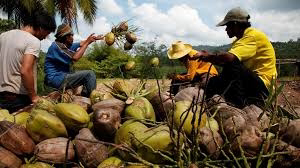Coconut farming
Coconut farming is a long-term process that involves several steps and takes several years to reach maturity. Here is a general overview of the timeline involved in coconut farming:
Seed Selection and Germination: Coconut farming starts with the selection of high-quality coconut seeds or seedlings. This step involves choosing healthy and disease-free seeds with good germination potential. The germination process typically takes around 2 to 3 months.
Nursery Stage: After germination, the coconut seedlings are transferred to a nursery, where they are grown for about 9 to 12 months. During this stage, the seedlings are cared for and provided with optimal conditions for growth, including proper watering, fertilization, and protection from pests and diseases.
Field Planting: Once the coconut seedlings reach a certain height and have developed a strong root system, they are ready to be transplanted to the field. This typically occurs when the seedlings are around 1 to 1.5 years old. The exact timing may vary depending on local conditions and farming practices.
Early Growth and Maintenance: After field planting, the coconut palms require regular maintenance, including proper irrigation, weed control, and fertilization. It takes about 4 to 5 years for the coconut palms to start bearing fruits. During this period, the farmer needs to ensure the plants receive adequate care to promote healthy growth.
Fruit Production and Harvesting: Once the coconut palms mature, they start producing coconuts. The exact timeline for fruit production can vary, but typically, it takes around 5 to 6 years from the time of planting. Coconut trees can continue to produce fruits for several decades.
Ongoing Maintenance: Coconut farming requires ongoing maintenance throughout the life of the trees. This includes regular pruning, pest and disease management, and nutrient management to ensure optimum growth and productivity.
Pollination: Coconut trees are typically cross-pollinated by insects, primarily bees. The male and female flowers of the coconut tree are separate, and pollination is essential for fruit development. This process occurs naturally through the movement of insects between flowers.
Fruit Development: After successful pollination, the coconuts begin to develop. It takes approximately 11 to 12 months for the coconuts to reach maturity. During this period, the coconuts undergo various stages of growth, from the initial formation to the development of the husk and the accumulation of coconut water and meat.
Harvesting: Coconut harvesting involves climbing the tall trees to collect the ripe coconuts. Depending on the height of the trees, specialized equipment such as long poles with cutting blades or climbers may be used. The harvesting frequency can vary depending on the region, but it is typically done every 2 to 3 months to collect the mature coconuts.
Processing and Utilization: Once harvested, coconuts can be utilized for various purposes. The outer husk can be removed to obtain the coconut fruit, which contains the water (liquid endosperm) and the white meat (kernel). These components can be used fresh, processed into various food products, or used for extracting coconut oil.
Replanting and Crop Rotation: Coconut trees have a long lifespan and can continue to produce coconuts for several decades. However, over time, the productivity of the trees may decline. Therefore, some farmers practice replanting and crop rotation to maintain the productivity of their coconut farms. This involves removing old and unproductive trees and replacing them with new seedlings.
It's important to remember that coconut farming practices can vary across different regions and farming systems. Local conditions, cultural practices, and specific coconut varieties may influence the timeline and techniques employed in coconut farming.
Follow me more details
Click on the link 🔗🖇️👇👇














Comments
Post a Comment